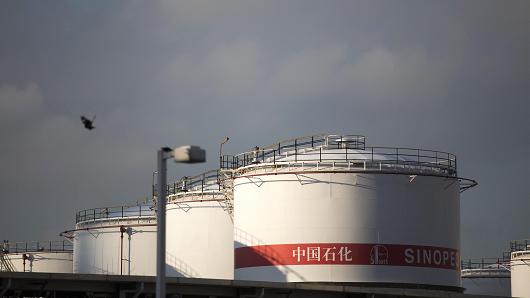China heads for record crude buying year

As China closes in on the United States as the world's biggest crude oil importer, demand from private refiners and stockpiling of cheap oil is expected to keep imports at record levels after a wobble in the third quarter.
Despite slower growth in recent months - crude imports rose just 1.3 percent in September on a year earlier - buying for October-November delivery has picked up strongly, traders and analysts say.
The purchases will ease concerns of a sharp slowdown in Chinese buying and support prices in coming months, analysts said.
The increased buying has shown up in tanker movements and freight rates, said Energy Aspects analyst Virendra Chauhan, and analysts are upgrading earlier forecasts for second half growth.
"Despite a slowing Chinese economy, crude imports remain robust on the back of accelerated stockpiling activities into operating and commercial storage," said Wendy Yong, analyst at oil consultancy FGE.
Since July, China has also granted nearly 700,000 barrels per day (bpd) of crude import quotas to small refiners, known as "teapots", or roughly 10 percent of China's current total imports, as part of efforts to boost competition and attract private investment, creating a new source of demand.
"The teapots are super-active," said one oil trader, with many racing to fill their new quotas.
And state-owned refiners are restocking after a third-quarter lull. Unipec, the trading arm of Asia's top refiner Sinopec, bought 6 million barrels of North Sea Forties crude and 2.9 million barrels of Russian ESPO for loading this month, and it has also stepped up Angolan crude purchases for November.
To accommodate the oil, new storage tanks on southern Hainan island have either been put to use or are due to be filled with crude from end-2015.
FGE expects China's crude imports in the second half to rise by 12 percent from a year ago, up from a previous estimate of 10 percent. It forecast China's crude imports to rise 9 percent for the year.
Such a rise would take Chinese imports to 6.75 million barrels per day, not far off U.S. imports of 7.3 million bpd. China's imports outpaced the United States in April were roughly on par in September.
Teapot refineries are unlikely to utilize the full amount of quotas allotted by the end of the year, but are widely expected to step up purchases in 2016.
At least three of the seven refiners to receive quotas, including Dongming Petrochemical and Panjin Beifang Asphalt Fuel which have the biggest allocations, have imported crude, traders said.
Hongrun Petrochemical, owned by Sinochem and also a recent receiver of a quota, has also stepped up imports, they said.
The newly licensed teapots recently bought supplies from the Asia-Pacific region as well as from Brazil and Colombia as they test a variety of grades to find the best fuel yield, traders said.
Other refiners, including Shandong Jinbo Petrochemical and inland plant Yanchang Petroleum, have also applied for import quotas.
Independent refiner Lijin Petrochemical bought a Russian ESPO cargo that arrived at its plant in September, and while it has stopped imports due to a refinery upgrade, orders would resume next year, said a source familiar with the matter.
Analysts said China would also continue to take advantage of low oil prices to build up its strategic petroleum reserves (SPR).
"Moving into 2016, crude imports are expected to pick up with the commissioning of a few major SPRs, though overall growth could ease to 5 percent from a stronger base amidst softer growth pace in crude runs," Yong said.
HEADLINES
- Do shipping markets want Biden or Trump for the win?
- All 18 crew safe after fire on Japanese-owned tanker off Singapore
- Singapore launching $44m co-investment initiative for maritime tech start-ups
- Cosco debuts Global Shipping Industry Chain Cooperation Initiative
- US warns of more shipping sanctions
- China continues seaport consolidation as Dalian offer goes unconditional